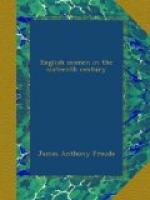Spanish commander, the bishop, and most of the people
fled, as at Vigo, into the mountains with their plate
and money. Carlile entered without opposition,
and flew St. George’s Cross from the castle
as a signal to the fleet. Drake came in, landed
the rest of his force, and took possession. It
happened to be the 17th of November—the
anniversary of the Queen’s accession—and
ships and batteries, dressed out with English flags,
celebrated the occasion with salvoes of cannon.
Houses and magazines were then searched and plundered.
Wine was found in large quantities, rich merchandise
for the Indian trade, and other valuables. Of
gold and silver nothing—it had all been
removed. Drake waited for a fortnight, hoping
that the Spaniards would treat for the ransom of the
city. When they made no sign, he marched twelve
miles inland to a village where the Governor and the
bishop were said to have taken refuge. But the
village was found deserted. The Spaniards had
gone to the mountains, where it was useless to follow
them, and were too proud to bargain with a pirate
chief. Sant Iago was a beautifully built city,
and Drake would perhaps have spared it; but a ship-boy
who had strayed was found murdered and barbarously
mutilated. The order was given to burn.
Houses, magazines, churches, public buildings were
turned to ashes, and the work being finished Drake
went on, as Santa Cruz expected, for the Spanish West
Indies. The Spaniards were magnificent in all
that they did and touched. They built their cities
in their new possessions on the most splendid models
of the Old World. St. Domingo and Carthagena
had their castles and cathedrals, palaces, squares,
and streets, grand and solid as those at Cadiz and
Seville, and raised as enduring monuments of the power
and greatness of the Castilian monarchs. To these
Drake meant to pay a visit. Beyond them was the
Isthmus, where he had made his first fame and fortune,
with Panama behind, the depot of the Indian treasure.
So far all had gone well with him. He had taken
what he wanted out of Vigo; he had destroyed Sant Iago
and had not lost a man. Unfortunately he had
now a worse enemy to deal with than Spanish galleons
or Spanish garrisons. He was in the heat of the
tropics. Yellow fever broke out and spread through
the fleet. Of those who caught the infection
few recovered, or recovered only to be the wrecks of
themselves. It was swift in its work. In
a few days more than two hundred had died. But
the north-east trade blew merrily. The fleet sped
on before it. In eighteen days they were in the
roads at Dominica, the island of brooks and rivers
and fruit. Limes and lemons and oranges were
not as yet. But there were leaves and roots of
the natural growth, known to the Caribs as antidotes
to the fever, and the Caribs, when they learnt that
the English were the Spaniards’ enemies, brought
them this precious remedy and taught them the use
of it. The ships were washed and ventilated,
and the water casks refilled. The infection seemed
to have gone as suddenly as it appeared, and again
all was well.




